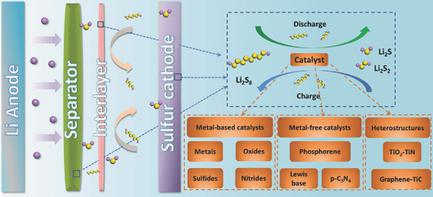Our official English website, www.x-mol.net, welcomes your
feedback! (Note: you will need to create a separate account there.)
Catalytic Effects in Lithium–Sulfur Batteries: Promoted Sulfur Transformation and Reduced Shuttle Effect
Advanced Science ( IF 14.3 ) Pub Date : 2017-09-05 , DOI: 10.1002/advs.201700270 Donghai Liu 1 , Chen Zhang 2 , Guangmin Zhou 3 , Wei Lv 4 , Guowei Ling 2 , Linjie Zhi 5 , Quan-Hong Yang 1, 4
Advanced Science ( IF 14.3 ) Pub Date : 2017-09-05 , DOI: 10.1002/advs.201700270 Donghai Liu 1 , Chen Zhang 2 , Guangmin Zhou 3 , Wei Lv 4 , Guowei Ling 2 , Linjie Zhi 5 , Quan-Hong Yang 1, 4
Affiliation

|
Lithium–sulfur (Li–S) battery has emerged as one of the most promising next‐generation energy‐storage systems. However, the shuttle effect greatly reduces the battery cycle life and sulfur utilization, which is great deterrent to its practical use. This paper reviews the tremendous efforts that are made to find a remedy for this problem, mostly through physical or chemical confinement of the lithium polysulfides (LiPSs). Intrinsically, this “confinement” has a relatively limited effect on improving the battery performance because in most cases, the LiPSs are “passively” blocked and cannot be reused. Thus, this strategy becomes less effective with a high sulfur loading and ultralong cycling. A more “positive” method that not only traps but also increases the subsequent conversion of LiPSs back to lithium sulfides is urgently needed to fundamentally solve the shuttle effect. Here, recent advances on catalytic effects in increasing the rate of conversion of soluble long‐chain LiPSs to insoluble short‐chain Li2S2/Li2S, and vice versa, are reviewed, and the roles of noble metals, metal oxides, metal sulfides, metal nitrides, and some metal‐free materials in this process are highlighted. Challenges and potential solutions for the design of catalytic cathodes and interlayers in Li–S battery are discussed in detail.
中文翻译:

锂硫电池中的催化作用:促进硫转化并减少穿梭效应
锂硫(Li-S)电池已成为最有前途的下一代储能系统之一。然而,穿梭效应大大降低了电池的循环寿命和硫的利用率,这对其实际使用产生了很大的阻碍。本文回顾了为寻找解决该问题的方法所做的巨大努力,主要是通过物理或化学限制多硫化锂(LiPS)。从本质上讲,这种“限制”对提高电池性能的作用相对有限,因为在大多数情况下,LiPS 被“被动”阻挡,无法重复使用。因此,这种策略在高硫负载和超长循环的情况下变得不太有效。迫切需要一种更“积极”的方法,不仅能捕获,还能增加随后LiPSs向硫化锂的转化,从根本上解决穿梭效应。本文综述了提高可溶性长链LiPSs向不溶性短链Li 2 S 2 /Li 2 S转化率以及反之亦然的催化作用的最新进展,以及贵金属、金属氧化物、重点介绍了该过程中的金属硫化物、金属氮化物和一些不含金属的材料。详细讨论了锂硫电池催化阴极和中间层设计的挑战和潜在解决方案。
更新日期:2017-09-05
中文翻译:

锂硫电池中的催化作用:促进硫转化并减少穿梭效应
锂硫(Li-S)电池已成为最有前途的下一代储能系统之一。然而,穿梭效应大大降低了电池的循环寿命和硫的利用率,这对其实际使用产生了很大的阻碍。本文回顾了为寻找解决该问题的方法所做的巨大努力,主要是通过物理或化学限制多硫化锂(LiPS)。从本质上讲,这种“限制”对提高电池性能的作用相对有限,因为在大多数情况下,LiPS 被“被动”阻挡,无法重复使用。因此,这种策略在高硫负载和超长循环的情况下变得不太有效。迫切需要一种更“积极”的方法,不仅能捕获,还能增加随后LiPSs向硫化锂的转化,从根本上解决穿梭效应。本文综述了提高可溶性长链LiPSs向不溶性短链Li 2 S 2 /Li 2 S转化率以及反之亦然的催化作用的最新进展,以及贵金属、金属氧化物、重点介绍了该过程中的金属硫化物、金属氮化物和一些不含金属的材料。详细讨论了锂硫电池催化阴极和中间层设计的挑战和潜在解决方案。











































 京公网安备 11010802027423号
京公网安备 11010802027423号